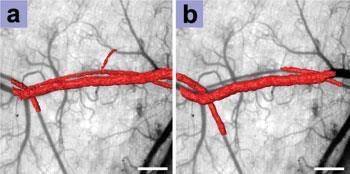Chemists have developed new compounds that can help to focus the activity of light-activated drugs with pinpoint accuracy
Chemists in the UK and Canada have developed a new molecule that can help doctors to destroy cancer cells with unprecedented precision, using a technique known as photodynamic therapy (PDT).
In PDT, a light-sensitive molecule, the photosensitiser, is introduced into the tissue and responds to a targeted beam of light by generating singlet oxygen, a highly reactive species that will destroy nearby cells. Existing photosensitisers are already used to treat some cancers and age-related macular degeneration - the most common cause of blindness in the elderly. But it is difficult to focus the treatment precisely on the target cells, and to penetrate deep into the body tissue.
The molecules developed by Harry Anderson’s group at the University of Oxford and tested for medical applications in Brian Wilson’s laboratory in Toronto, Canada, are going to overcome both these hurdles, the researchers claim. Their compounds use a process known as two-photon-excitation (TPE), where the molecule enters the excited state only if it absorbs two photons at the same time.

’Since the amount of TPE depends on the square of the light intensity, it gives pinpoint accuracy - in a focussed beam of light, the amount of TPE is inversely proportional to the fourth power of the distance from the focus,’ Anderson explains, adding: ’since two photons are used to excite the photosensitiser, each photon only needs half as much energy as for one-photon excitation, and low-energy long-wavelength photons travel further through living tissues.’
Out of the new compounds, a family of porphyrin dimers linked by conjugated triple bonds, had the highest PDT activity and was selected for in vivo experiments. The PhD student who synthesised this compound in Oxford, Hazel Collins, was also involved in the biomedical part of the project conducted at the University of Toronto, where she showed that this porphyrin dimer performs well in the targeted closure of blood vessels in vivo. This experiment suggests that the new photosensitiser would work well in the treatment of age-related macular degeneration, the authors say.

Sandy MacRobert, who investigates PDT at University College London, praised the new work. ’The key advance presented here is to harness the precision of multiphoton laser irradiation to carry out non-thermal photochemical treatment of selected sites inside the tissue - in this case blood vessels - and the authors have amply demonstrated the impressive spatial selectivity that can be achieved,’ he told Chemistry World.
MacRobert agrees the most imminent application will be in macular degeneration. ’But without doubt other possibilities will emerge particularly in neurosurgey where precise minimally-invasive treatment is of key importance,’ he added.
Michael Gross
Interesting? Spread the word using the ’tools’ menu on the left.
References
et al.Nature PhotonicsDOI:10.1038/nphoton.2008.100






No comments yet